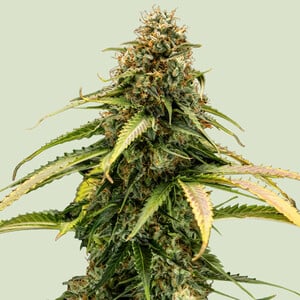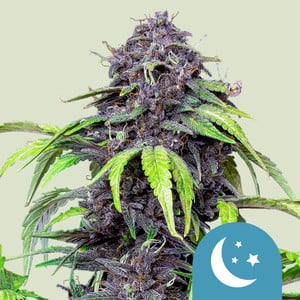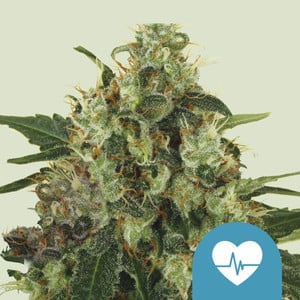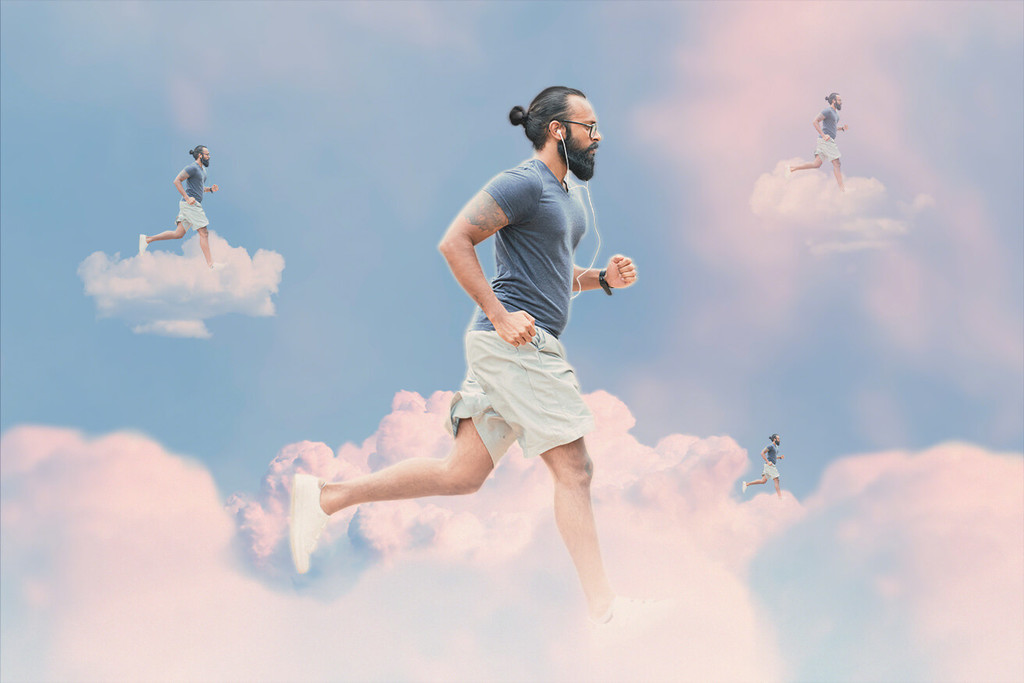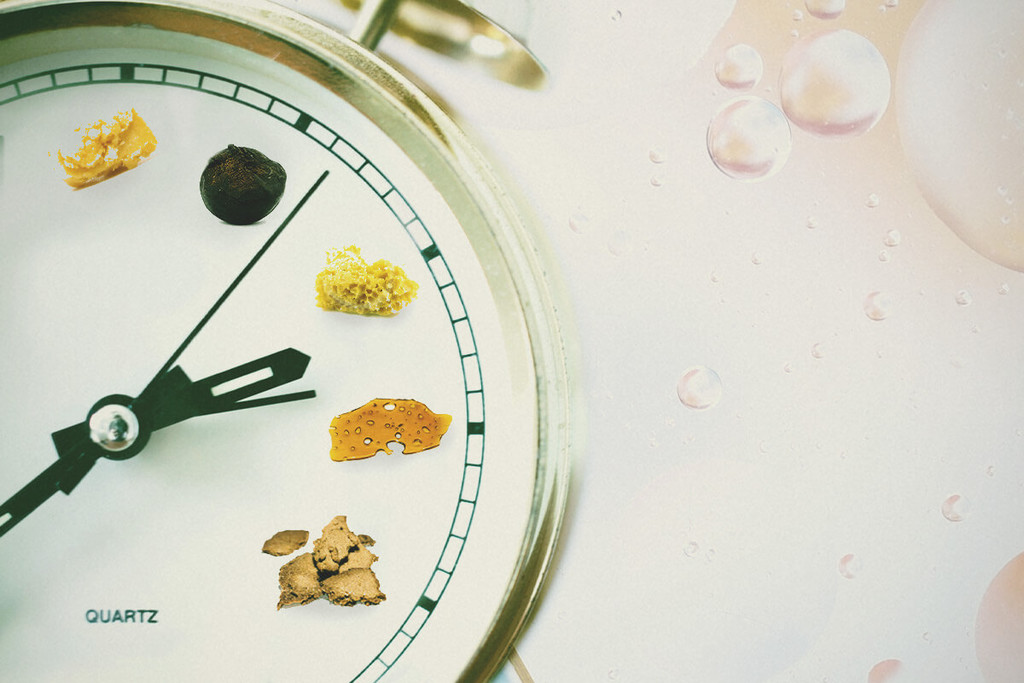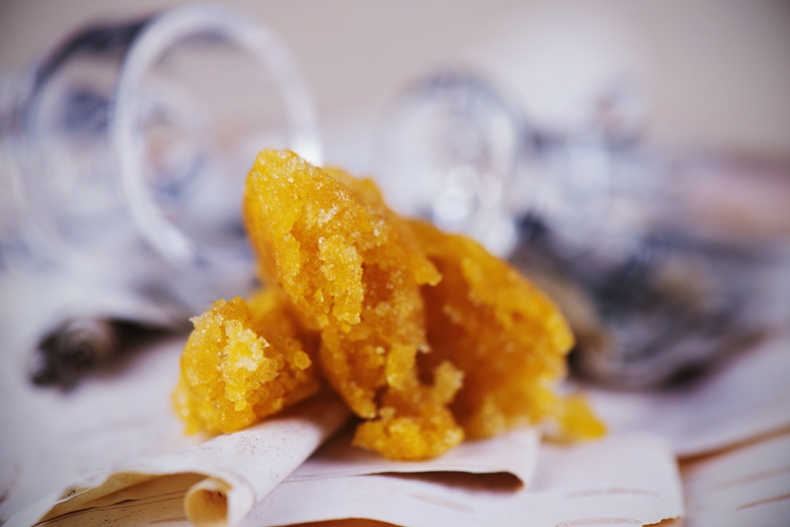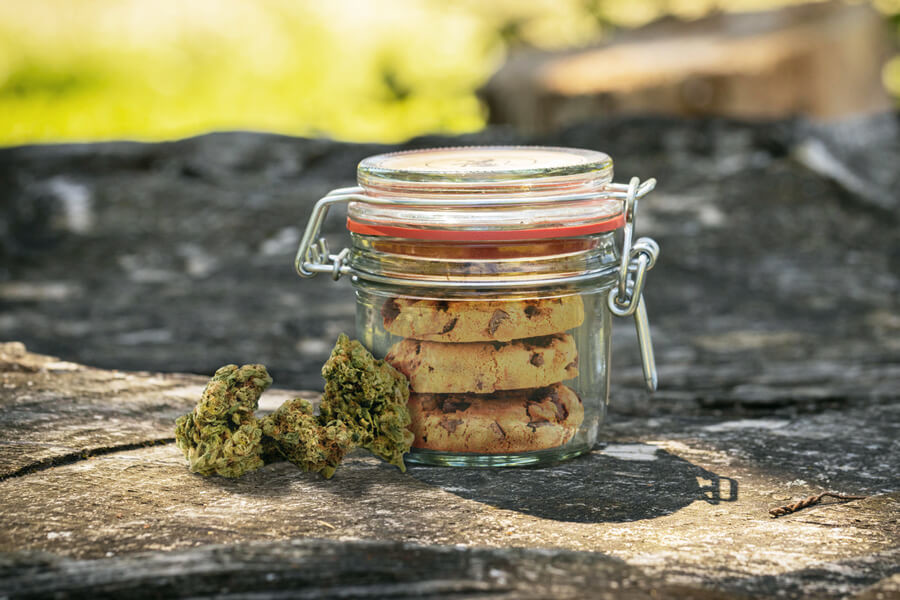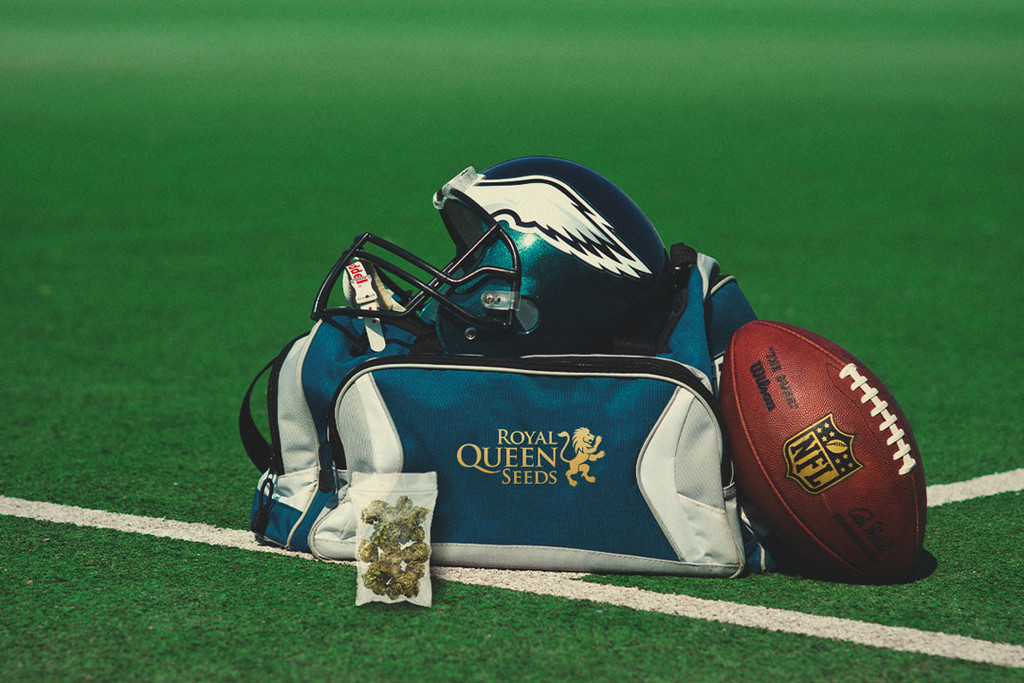.
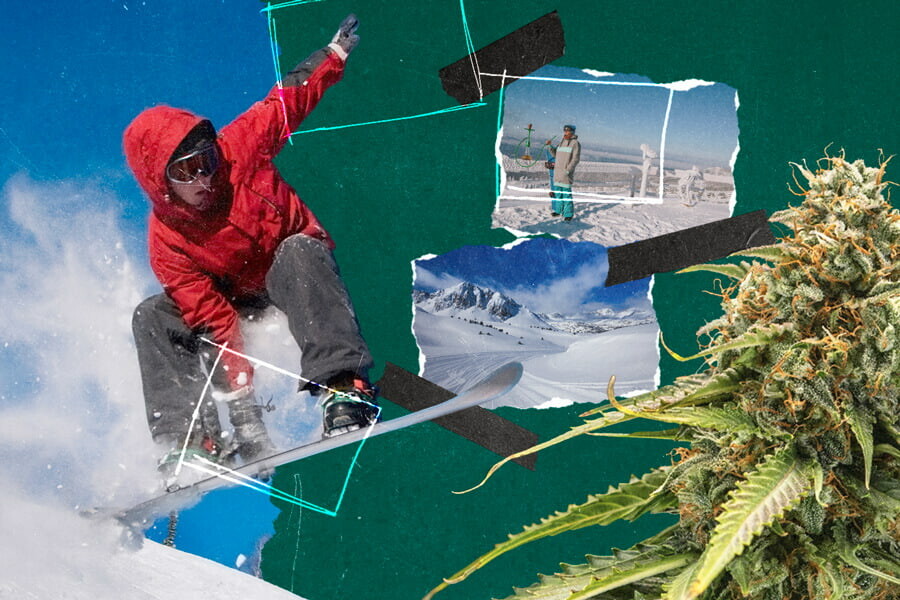
Cannabis & Snowboarding: How to Combine Them
Cannabis and snowboarding go together like a cold hand and a warm mitten. Below, we're going to walk you through everything you need to consider when it comes to staying elevated while shredding the slopes. Discover the complex legal situation, how to optimise your experience, and the best cannabis strains for snowboarding!
Contents:
Cannabis and board sports have a long and intimate history. Originating as counter-cultural activities, both have successfully entered the mainstream, and they continue to maintain close ties up to this day. Alongside skateboarders and surfers, snowboarders have a long-established relationship with the herb. From keen amateurs to seasoned pros, many enjoy the effects of cannabis while gently carving down slopes or heading full speed into gnarly jumps.
Continue reading to discover a brief history of snowboarding, why weed and snowboarding go hand in hand, and the best strains for pairing with this beloved winter sport.
A Brief History of Snowboarding
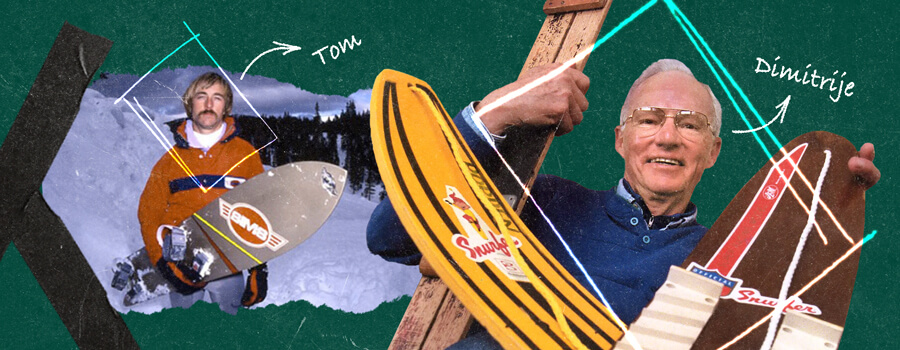
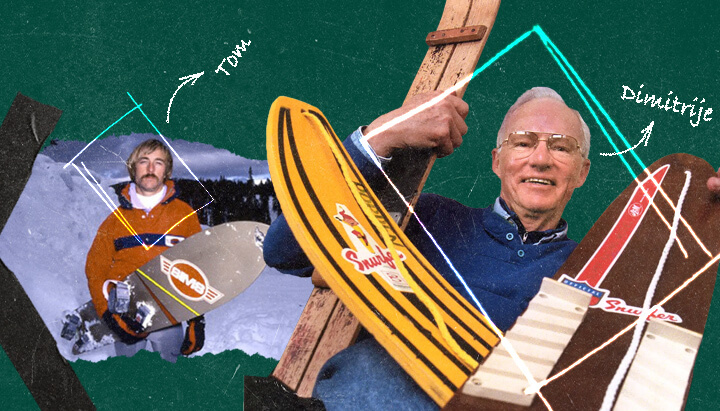
Snowboarding comes from humble yet innovative roots. Its beginnings go back to the 1960s when Sherman Poppen invented the Snurfer—the predecessor to modern snowboards. In an attempt to build a toy for his children to enjoy, Poppen created a monoski designed to “surf” on the snow. The basic design featured two stomp pads and, just like skateboards and surfboards, had no binding. Snurfer racing clubs started to form around Michigan during the late 1960s into the early 1970s, before two Russian inventors started to tweak the design, giving rise to Snurfer clubs in Moscow.
During this time, an East Coast surfer named Dimitrije Milovich started to develop a snowboard based on the newest surfboard designs. His model featured strong steel edges, a laminated fibreglass board, and nylon bindings to strap the board to his boots. During the late 1970s, the 23-year-old student Jake Burton contributed to innovation in the area by creating a flexible wooden board. The passionate Snurfer and pro skater Tom Sims also started to produce snowboards of his own during this era.
With the quintessential snowboard design now complete, the only thing holding snowboarding back was its acceptance in society. During the 1980s, ski resorts strictly prohibited snowboarding, forcing the early pioneers of the sport to either sneak onto the slopes during the night or head out to the backcountry in search of suitable locations. However, its increasing popularity soon gave rise to further design innovations and widespread competitions, culminating in snowboarding becoming the fastest-growing winter sport during the middle of the 1990s. In 1998, snowboarding made its international debut in the Winter Olympics in Japan, cementing its rightful place among winter sports forever.
Cannabis and Snowboarding in the Modern Era
The snowboarding industry has evolved into a behemoth in the modern era, with its global equipment market[1] projected to reach $416 million in 2031. The rebellious roots of snowboarding, and its culture of thrill-seeking nature lovers, means cannabis and snowboarding have gravitated towards one another over time. Widespread legalization of the plant in countries such as the United States and Canada also means many snowboarders have an easy time accessing cannabis. However, legal complexities in some areas makes successfully pairing weed and snowboarding challenging.
-
Cannabis Legality
Even in countries that have legalized cannabis cultivation and use, some snowboarders have an exceptionally hard time finding somewhere to blaze up and shred some slopes. Take the United States, for instance. Here, states with popular snowboarding locations, such as Colorado and California, have legalized cannabis. However, many resorts are placed on federal land, where cannabis use remains illegal under prohibitive federal laws.
Across the border in Canada, where cannabis is legal countrywide, ski resorts continue to enforce strict anti-cannabis policies. Town councils in Banff have passed bylaws banning smoking cannabis in all public places, and Mount Seymour in North Vancouver has been declared a “no smoking mountain”. Cannabis-loving snowboarders in Europe face a similar situation. Even where cannabis is legal, decriminalised, or generally tolerated, many resorts are marketed towards families with young children and have strict policies against cannabis use.
So, where does this leave snowboarders who like to blaze before riding? As you can imagine, they’re limited to two choices: use cannabis stealthily at a resort, or head out into the backcountry where they lack the luxuries of maintained slopes and ski lifts. However, cannabis product innovations such as vapes and edibles make covert consumption much easier, and backcountry snowboarding has evolved into a popular niche within the sport.
-
Professional Snowboarders and Weed
As the stigma around cannabis use continues to fade, more and more pro athletes across a range of sports are making their cannabis use public, including the likes of Mike Tyson, Conor McGregor, and NBA Hall-of-Famer Allen Iverson. Similarly, some of the giants in the world of snowboarding are more than happy to let the world know about their relationship with the herb.
Ross Rebagliati
Take just a quick glance at Ross Rebagliati’s Instagram account, and it quickly becomes apparent that cannabis plays a bigger part in his life than snowboarding. A native of Vancouver, Canada, Rebagliati started shredding slopes at the age of 15 and went on to win both the Canadian and United States Amateur Snowboard Championships in 1990. The peak of his career occurred at the 1998 Winter Olympics—and wasn’t without some cannabis controversy.
After winning gold in the men’s giant slalom event, the International Olympic Committee stripped him of his medal following a failed cannabis drug test. However, after a short appeal period, Rebagliati had his medal restored. Since his athletic peak, he’s gone on to advocate for cannabis legalization in Canada and believes the herb has performance-enhancing properties. In 2013, Rebagliati and his business partner Patrick Smyth launched their medical marijuana business Ross’ Gold.
Circe Wallace
Circe Wallace has developed an impressive legacy in the world of snowboarding, from competing in the first-ever X Games and winning a world championship in Japan to collaborating with Vans to create the first snowboarding boot designed specifically for women. Since her days of dominance in the sport, Wallace went on to launch her cannabis extraction company Hot Nife in 2017. Focused on manufacturing high-end full-spectrum products using CO₂ extraction, her business distributes extracts to dispensaries throughout Southern California. Speaking on her relationship with the herb[2] to The Aspen Times, Wallace expressed: “Cannabis has been pretty omnipresent in my life. I grew up as a skateboarder and a snowboarder in Oregon and Washington and it was in rotation pretty regularly”.
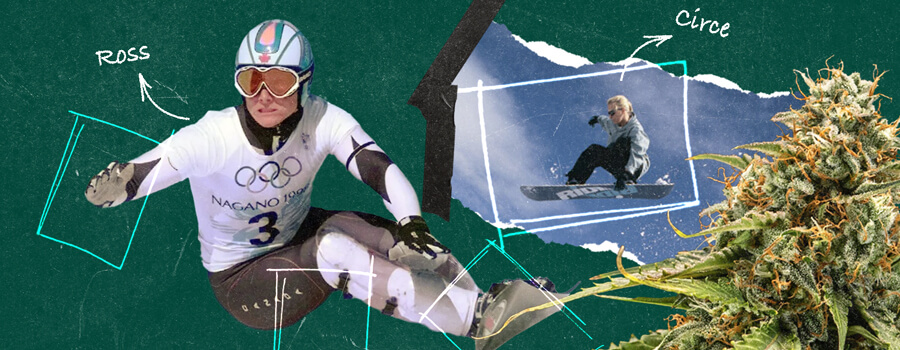
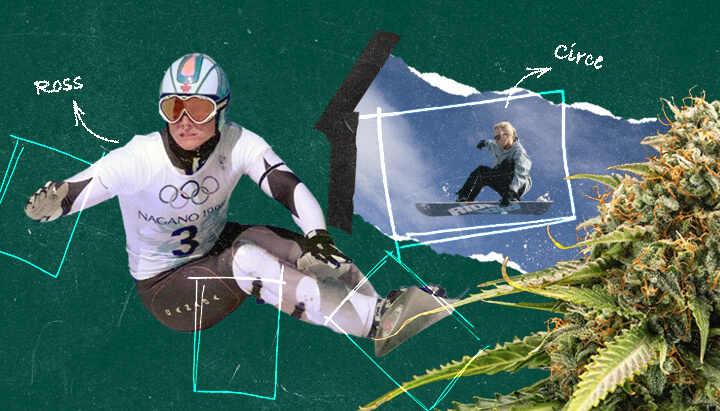
Is It a Good Idea to Smoke Weed and Snowboard?
At face value, marijuana and snowboarding seem like a perfect match. But are there any drawbacks? Some research suggests that cannabis use could decrease performance on the slopes. For example, a meta-analysis[3] published in 2024 found an association between acute cannabis use and slower reaction times, whereas a human study[4] involving 20 recreational users found that a strain with a THC content of 13% resulted in impaired motor control in participants for up to six hours after consumption.
But not all studies in this area have yielded similar results. Other research efforts have found no association[5] between cannabis use and impaired reaction time, and research[6] published in the Journal of Cannabis Research in 2024 suggests that acquired tolerance to THC through regular use might reduce the negative impact on motor control.
While reaction time and motor control are extremely important when snowboarding, the demands placed on the nervous system vary depending on the intensity and complexity of the activity. For example, pros travelling at high speeds and performing technical tricks require more refined motor control and face higher consequences if their reaction time is impaired. Yet, pro snowboarders such as Ross Rebagliati have gone on record claiming that using cannabis enhances their performance instead of hampering it. Furthermore, not all people who pair snowboarding with cannabis are performing at such a high level. Many are more than content with hitting a joint and gently carving down slopes—a laid-back activity with much lower consequences.
Tips for Using Cannabis While Snowboarding
If you’re planning on using cannabis before your next session and joining the ranks of stoner snowboarders, here are several factors you should consider to optimise your experience.
- Ditch smoking: Snowboarding is a tough cardiovascular workout that challenges the heart and lungs. Swap out smoking for vaping or sublingual tinctures, both on and off the slopes, to stay in tip-top shape.
- Opt for energising strains: The countless cannabis strains available generally fall into one of two categories: stoning and energising. While relaxing varieties have their time and place, opt for energising strains when snowboarding to keep your mind in the zone.
- Try high-CBD options: Cannabis and THC are not synonymous. Strains high in CBD with equal parts THC—or no THC at all—will keep your mind clear and functional, and are a great alternative to more potent strains during physical activities.
- Stay hydrated: The physical exertion involved in snowboarding sends the heart rate through the roof, causing the body to lose a lot of fluids through sweating. Adding to this, cannabis use typically causes a temporary decrease in saliva production[7], giving rise to the common side effect of cotton mouth. Bring plenty of water along to stay hydrated and counter the unpleasant sensation of a dry mouth.
- Bring snacks: You’ll burn roughly 450 calories per hour[8] while snowboarding. On top of this, high-THC strains will likely trigger the munchies at some point during your session. Bring plenty of healthy snacks along, such as fresh fruit, nuts, and seeds, to conquer food cravings and re-energise.
- Take it easy: Follow the conventional wisdom of going “low and slow” when pairing weed and snowboarding for the first time, and aim for enjoyment over performance. Start out with just a few hits from a vape using a high-CBD or moderately strong THC-containing strain. Enjoy carving at a slow pace while you get to grips with any new sensations, and take things from there.
Recommended Cannabis Strains for Snowboarding
There are virtually limitless options when it comes to using specific cannabis strains while snowboarding, but some are much better suited to the job than others. Discover the very best snowboard weed available below.
Epsilon F1
If you have a high tolerance to THC and experience combining bud with boarding, Epsilon F1 could quickly become your perfect botanical partner for the slopes. This vigorous F1 hybrid boasts sky-high levels of THC, delicious flavours of blueberry and lavender, and provides a bountiful yield just 60 days after sprouting.
Epsilon F1
|
|
Blue Dream x Blueberry x Amnesia Lemon Haze x Black Domina |
|
|
30 - 40 days |
|
|
THC: Very high |
|
|
Calming, Long Lasting , Physically Relaxing |
|
|
60 days after germination |
Purplematic CBD
As one of the most aesthetically pleasing strains in the RQS library, Purplematic CBD produces large, deep purple colas that become the centrepiece of any grow room or garden. With a CBD content of 17% and negligible THC concentrations of 0.5%, this indica-dominant hybrid provides mental clarity and focus without a high. Plus, you’ll enjoy indoor yields of 375–450 g/m² and outdoor harvests of 110–150 g/plant after a growing cycle of just 8–9 weeks.
Purplematic CBD
|
|
Kush Rose Auto CBD x Afghan Rose Auto CBD |
|
|
375 - 450 gr/m2 |
|
|
70 - 120 cm |
|
|
7 - 8 weeks |
|
|
THC: 0,5% |
|
|
Sativa 5% Indica 90% Ruderalis 5% |
|
|
110 - 150 gr/plant |
|
|
100 - 140 cm |
|
|
8 - 9 weeks after sprouting |
|
|
Calming, Clear |
Medical Mass
With a perfect balance of THC and CBD, at concentrations of 10% each, Medical Mass provides the best of both worlds. You’ll experience a light, subtle, but euphoric high alongside a boost in mental clarity. This strain is the perfect option if you want to enjoy the effects of THC while cruising down slopes without becoming overwhelmed or experiencing impaired coordination. Grow this strain indoors for yields of 500–550 g/m², or outdoors in a sunny and fertile spot for returns of up to 550 g/plant.
Medical Mass
|
|
Critical Mass x CBD dominant plant |
|
|
500 - 550 gr/m2 |
|
|
60 - 100 cm |
|
|
10 - 11 weeks |
|
|
THC: 10% |
|
|
Sativa 40% Indica 60% |
|
|
500 - 550 gr/plant |
|
|
120 - 150 cm |
|
|
Late September |
|
|
Calming, Physically Relaxing |
Weed & Snowboarding: How Compatible Are They?
Cannabis and snowboarding have some profound similarities. Despite legal barriers, more and more snowboarders are utilising cannabis before hitting the slopes or heading into the backcountry to elevate their experience. While research remains mixed as to how THC impacts reaction time and motor control, some of the best borders of all time have expressed their support for using the herb alongside the sport. As a result, some companies in the cannabis industry have started marketing products to stoner snowboarders, from CBD creams aimed to assist recovery to pre-rolled joints for easy smoking out in the snow.
If you decide that combining cannabis and snowboarding is right for you, make sure to follow the tips above for the most memorable and pleasant experience possible.
- Snowboard Equipment Market Size, Share, 2031 | Global Report https://www.businessresearchinsights.com
- High Country: Snowboarding legend Circe Wallace carves her way into cannabis | AspenTimes.com https://www.aspentimes.com
- Effects of acute cannabis inhalation on reaction time, decision-making, and memory using a tablet-based application - PMC https://pmc.ncbi.nlm.nih.gov
- High-Potency Marijuana Impairs Executive Function and Inhibitory Motor Control | Neuropsychopharmacology https://www.nature.com
- Effects of marijuana on human reaction time and motor control - PubMed https://pubmed.ncbi.nlm.nih.gov
- Effects of acute cannabis inhalation on reaction time, decision-making, and memory using a tablet-based application - PMC https://pmc.ncbi.nlm.nih.gov
- Cannabinoid CB1 receptors regulate salivation - PMC https://pmc.ncbi.nlm.nih.gov
- Which is a Better Workout: Skiing or Snowboarding? https://www.outsideonline.com


























